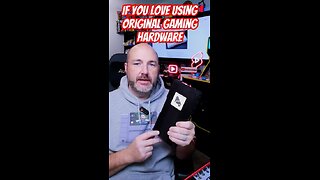Premium Only Content

Should You Buy the Hyperkin HDTV Cable for the Nintendo Super NES, Super Famicom, N64, & Gamecube?
In this video, we unbox and test the Hyperkin HDTV cable designed to work with the Super Nintendo, N64, and GameCube.
One of the biggest retro gaming challenges can be how to get a decent picture out of your system when connected to a flat panel TV. I mean, composite looks terrible when blown up. Hyperkin HDTV Cables are perhaps one of the easiest and most budget-friendly ways to connect these systems. They offer solutions for a variety of systems, including the one that we are looking at here today, which fits Nintendo systems with the multi output ports.
The 7-foot long cable is fairly simple and straightforward. The connector that plugs into your system is molded composite, and fits into the systems rather well. You neither have to force it in nor does it feel like it's going to fall out. To connect to your TV, a metal HDMI compatible plug is hardwired on to the cable.
Unlike other solutions, this is truly plug-and-play and does not require any modifications of your system to make it work. That being said, my Super NES Jr, which I have modified with one of Voltar's RGB mod kits did not work with this cable at all. Now, I do not have the S-video output connected, which may cause the issue, but I also don't have it connected on my N64, also RGB modded, & ran into no such issues.
Upon plugging in to my Super NES & firing up Donkey Kong Country, I noticed the colors were significantly less vibrant compared to RGB cables. I also noticed additional graininess and artifacting, fairly similar to when I use AV2HDMI adapters, but slightly crisper.
In speaking with one of the people at my local retro store, he had mentioned that some people had complained audio loss the longer you played a game through the system. According to what he has had reported, this is isolated only to the Nintendo cable. He is tested out several on the store and he has been able to duplicate the issue. I, however, have not, but I did want to share this information with you.
Bouncing from system to system, what I found with this cable was very similar to what I found with other solution such as this. The higher the video quality output from the original system, the better the video quality through this cable will look. The GameCube video looks crisper than the N64, which looks crisper than the SNES.
Why it RoX:
- Only $30
- Plug-N-Play
- Works with NTSC + NTSC-J SNES, N64 & GameCube
- Aspect ratio selection switch
- Respectable video quality
- Micro USB power cable included
What could be improved?
- Dongle design instead of a cable design would allow me to use whatever length HDMI cable needed
- All of my systems required separate power
- Less-vibrant colors
- Some reports of audio fading issues locally
Should you buy one?
If you are looking for a quick and easy way to connect your SNES, N64, or GameCube to your modern flat panel TV, for $30 it actually does a halfway decent job. It is considerably less expensive than other upscalers and component cables out there, but you do get reduced image quality & slight lag introduced. I can see myself using this cable to take to conventions vs dragging my OSSC or RetroTink & HD Retrovision cables with me. I can see using this cable to connect to a projector to play outside on a starlit night. I think this is a decent place for you to start, but know there are better solutions out there that you may want to investigate long-term that will yield more authentic-looking results.
The footage used in this review are used under the Fair Use laws, referenced below:
https://www.law.cornell.edu/uscode/text/17/107
Notwithstanding the provisions of sections 106 and 106A, the fair use of a copyrighted work, including such use by reproduction in copies or phonorecords or by any other means specified by that section, for purposes such as criticism, comment, news reporting, teaching (including multiple copies for classroom use), scholarship, or research, is not an infringement of copyright. In determining whether the use made of a work in any particular case is a fair use the factors to be considered shall include—
(1) the purpose and character of the use, including whether such use is of a commercial nature or is for nonprofit educational purposes;
(2) the nature of the copyrighted work;
(3) the amount and substantiality of the portion used in relation to the copyrighted work as a whole; and
(4) the effect of the use upon the potential market for or value of the copyrighted work.
The fact that a work is unpublished shall not itself bar a finding of fair use if such finding is made upon consideration of all the above factors.
(Pub. L. 94–553, title I, § 101, Oct. 19, 1976, 90 Stat. 2546; Pub. L. 101–650, title VI, § 607, Dec. 1, 1990, 104 Stat. 5132; Pub. L. 102–492, Oct. 24, 1992, 106 Stat. 3145.)
-
 2:42
2:42
RoXolidProductions
3 months agoMore Affordable 4K Gaming Upscaling + Best Budget Upscaler Returns!
115 -
 UPCOMING
UPCOMING
Glenn Greenwald
22 minutes agoRapid Fire: Canada Elections, Dem's Sit-In, Israeli Taking Points Escalate; PLUS: Jewish Academics Push-Back on Antisemitism Claims | SYSTEM UPDATE #445
1 -
 LIVE
LIVE
BonginoReport
3 hours agoDeportations Keep “Frightened” Michelle Obama Awake at Night (Ep. 37) - Nightly Scroll with Hayley
22,302 watching -
 1:18:44
1:18:44
Kim Iversen
2 hours agoMagnetic Pole Shift: Europe’s Blackout Is Just the Beginning | 90° Earth Flip Coming
40.2K23 -
 LIVE
LIVE
Laura Loomer
1 hour agoEP118: LIVE COVERAGE: Trump Celebrates 100 Days In Office At Michigan Rally
1,704 watching -
 LIVE
LIVE
Barry Cunningham
8 hours agoWATCH TRUMP RALLY LIVE: PRESIDENT TRUMP MARKS 100 DAYS IN OFFICE WITH A RALLY IN MICHIGAN
1,693 watching -
 LIVE
LIVE
Badlands Media
8 hours agoBadlands Media Special Coverage: President Trump's 1st 100 Days Rally
1,055 watching -
 16:12
16:12
T-SPLY
7 hours agoJeff Bezos Is Now Enemy #1 For The Trump Administration
32.3K35 -
 7:27
7:27
China Uncensored
7 hours agoChina’s DISTURBING Expansion in Africa
7503 -
 1:24:27
1:24:27
Redacted News
3 hours agoELECTION SHOCK! Canada Declares War on U.S. and Trump, India going to war with Pakistan? | Redacted
109K196